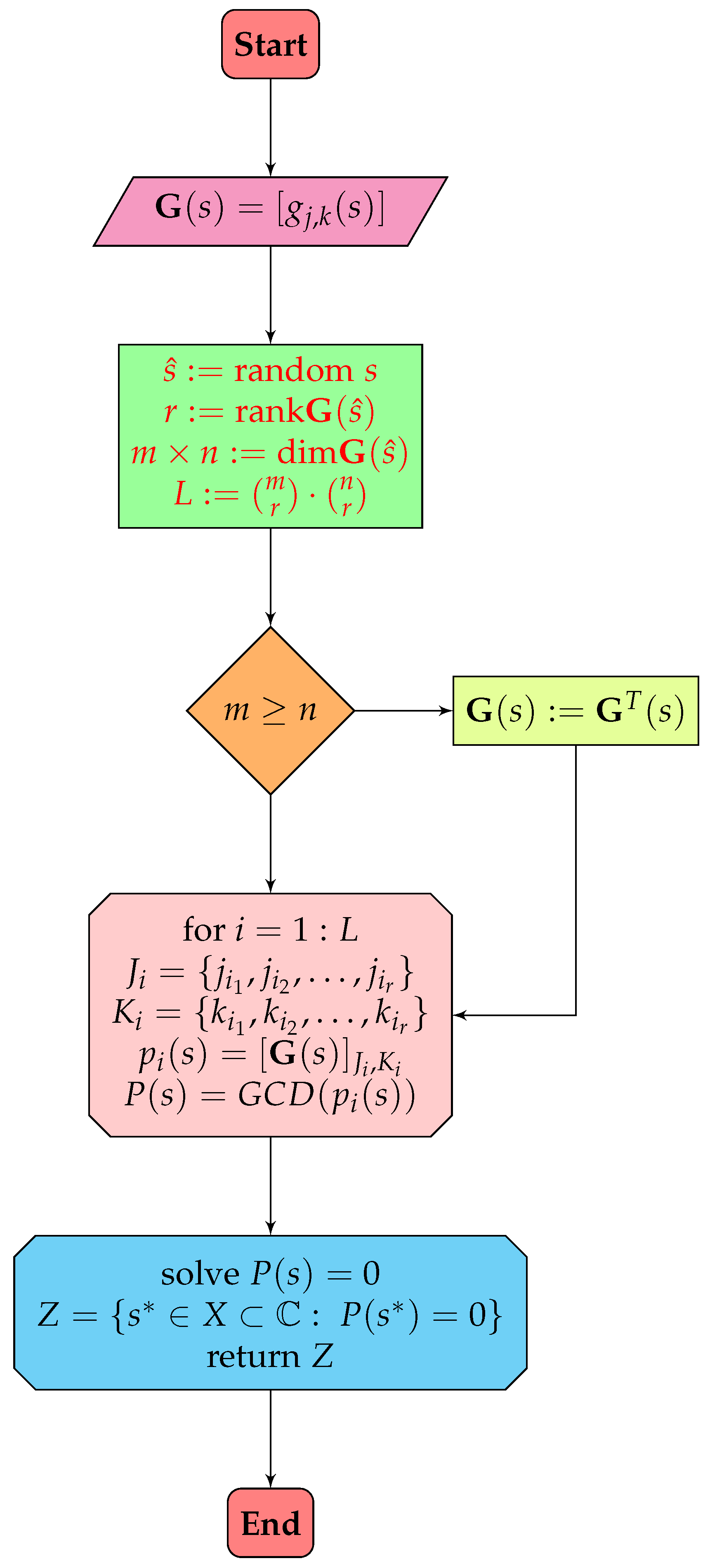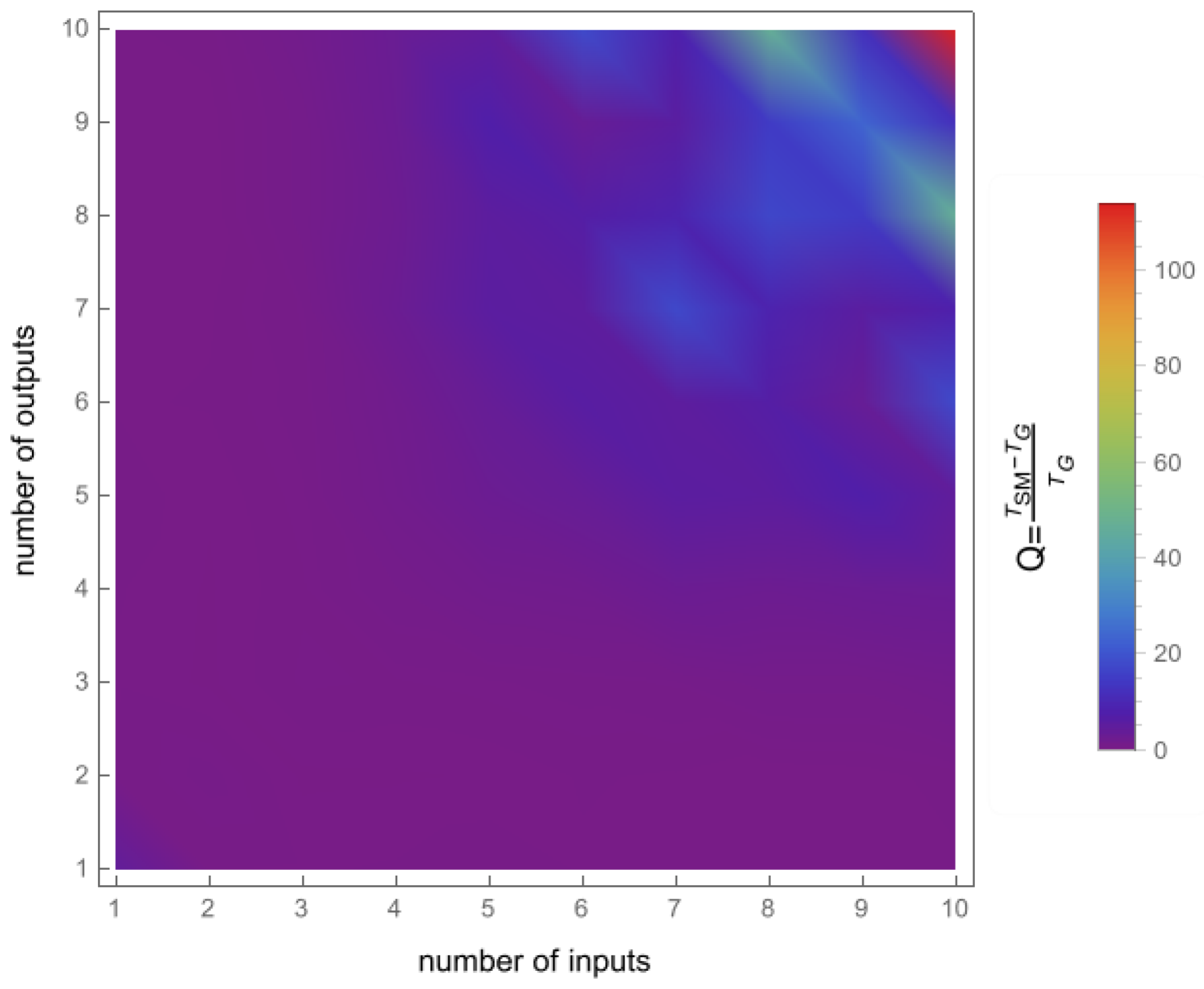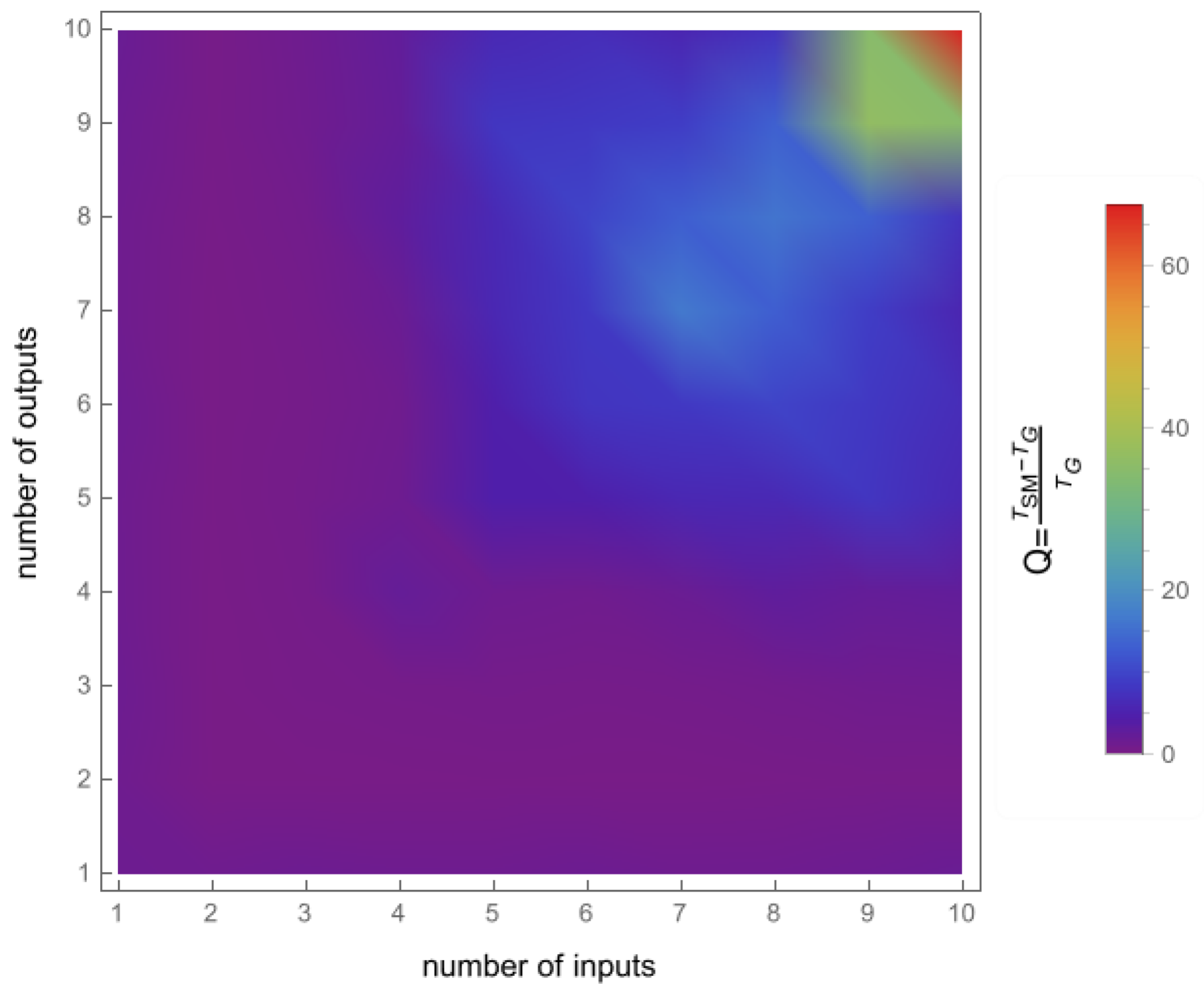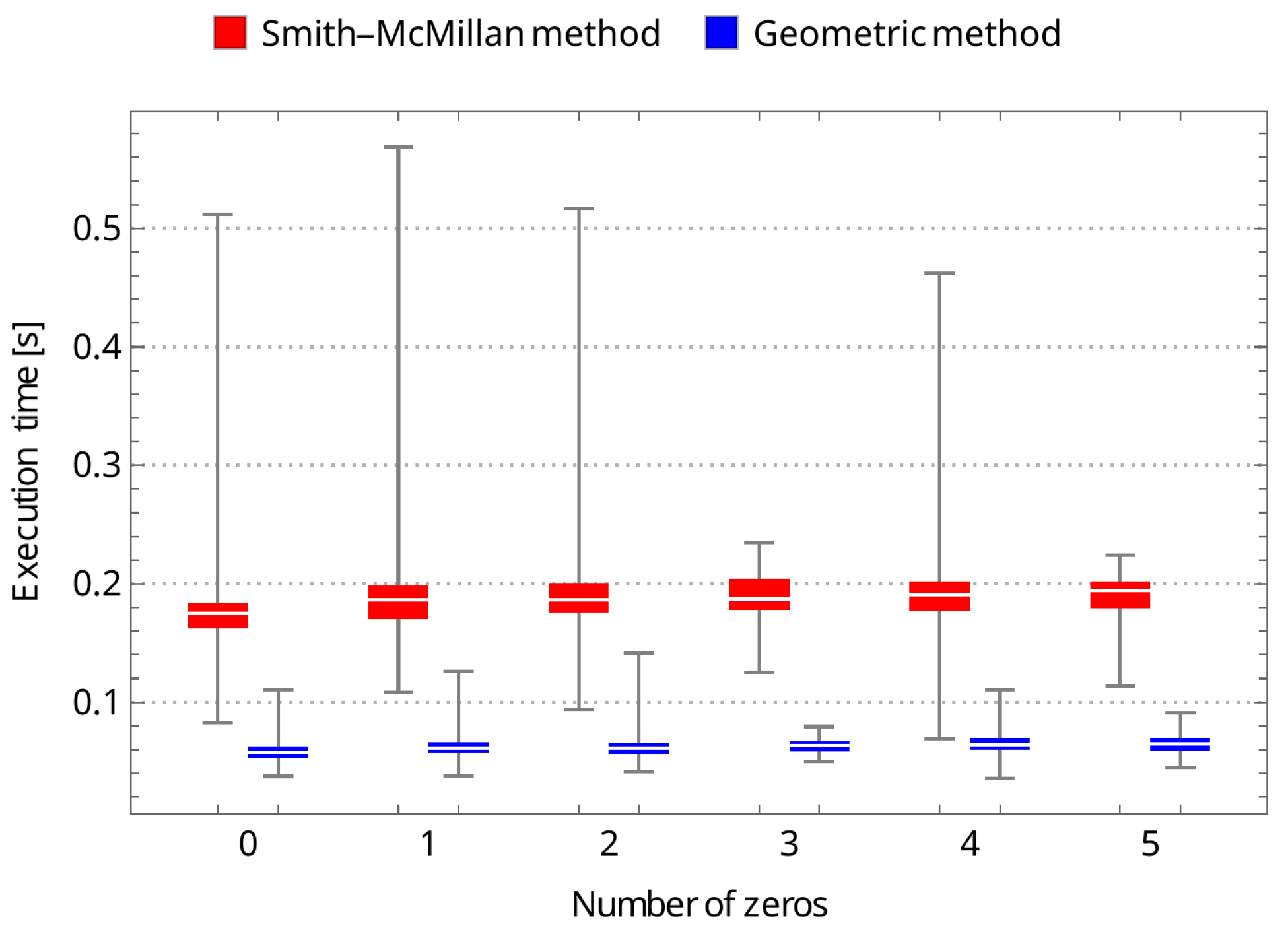Examination of Transmission Zeros in the MIMO Sensor-Based Propagation Environment Using a New Geometric Procedure
Abstract
:1. Introduction
- We effectively present the new geometric method addressing the calculation of transmission zeros.
- The discussed method is strictly associated with the multivariable systems encompassing different numbers of input and output variables.
- The approach undeniably outperforms the classical solution based on the Smith–McMillan decomposition.
- The advantages of the proposed method are understood in terms of reducing the computational effort, ultimately leading to the adaptation of the algorithm to real-time operations.
- A detrimental effect of stable and unstable transmission zeros is eliminated as a result of the running procedure. Henceforth, the innovative tool can also be used for systems without discussed zeros.
- Since the geometric-originated strategy can be used in various domains, it provides a solid background for other theoretical and practical applications.
- The contribution of the new geometric method to a wide range of physical scenarios is clearly visible, e.g., it can be used in advanced signal processing as well as in modern control theory and practice.
- The great potential of the newly introduced approach provides a set of open problems. For example, the method can be evaluated with respect to its applicability to ill-conditioned matrices.
2. System Description
3. Smith–McMillan Factorization for Multivariable Systems
4. A New Method of Calculation of Transmission Zeros
4.1. Computational Effort
| Algorithm 1 Geometric method algorithm: The pseudocode of the geometric method procedure. |
|
4.2. Algorithm Running Time
4.3. Discussions of the Obtained Results
5. Conclusions and Open Problems
Author Contributions
Funding
Institutional Review Board Statement
Informed Consent Statement
Data Availability Statement
Conflicts of Interest
References
- Latawiec, K.J. Control zeros and maximum-accuracy/maximum-speed control of LTI MIMO discrete-time systems. Control. Cybern. 2005, 34, 453–475. [Google Scholar]
- Hunek, W.P.; Majewski, P. Perfect reconstruction of signal—A new polynomial matrix inverse approach. EURASIP J. Wirel. Commun. Netw. 2018, 2018, 107. [Google Scholar] [CrossRef]
- Pradhan, N.C.; Koziel, S.; Barik, R.K.; Pietrenko-Dabrowska, A. Bandwidth-Controllable Third-Order Band Pass Filter Using Substrate-Integrated Full- and Semi-Circular Cavities. Sensors 2023, 23, 6162. [Google Scholar] [CrossRef] [PubMed]
- Magnuski, M.; Noga, A.; Surma, M.; Wójcik, D. Modified Triple-Tuned Bandpass Filter with Two Concurrently Tuned Transmission Zeros. Sensors 2022, 22, 9760. [Google Scholar] [CrossRef] [PubMed]
- Pathak, S.; Piron, D.; Paknejad, A.; Collette, C.; Deraemaeker, A. On transmission Zeros of piezoelectric structures. J. Intell. Mater. Syst. Struct. 2022, 33, 1538–1561. [Google Scholar] [CrossRef]
- Golzar, M.H.; Kheirdoost, A.; Haghparast, M.; Ahmadi, B. A systematic approach towards realization of transmission zeros in TE01δ mode dielectric resonator filters with all iris couplings. IET Microwaves Antennas Propag. 2022, 16, 124–136. [Google Scholar] [CrossRef]
- Basit, A.; Daraz, A.; Khan, M.I.; Zubir, F.; Al Qahtani, S.A.; Zhang, G. Design and Modelling of a Compact Triband Passband Filter for GPS, WiMAX, and Satellite Applications with Multiple Transmission Zero’s. Fractal Fract. 2023, 7, 511. [Google Scholar] [CrossRef]
- Latawiec, K.; Bańka, S.; Tokarzewski, J. Control zeros and nonminimum phase LTI MIMO systems. Annu. Rev. Control. 2000, 24, 105–112. [Google Scholar] [CrossRef]
- Ojaroudi Parchin, N. Antenna Design for 5G and Beyond; MDPI-Multidisciplinary Digital Publishing Institute: Basel, Switzerland, 2022; Available online: https://www.mdpi.com/books/pdfdownload/book/5238 (accessed on 19 January 2024).
- Kebede, T.; Wondie, Y.; Steinbrunn, J.; Kassa, H.B.; Kornegay, K.T. Precoding and Beamforming Techniques in mmWave-Massive MIMO: Performance Assessment. IEEE Access 2022, 10, 16365–16387. [Google Scholar] [CrossRef]
- Meng, F.; Ma, K.; Yeo, K.S.; Xu, S.; Nagarajan, M. A compact 60 GHz LTCC microstrip bandpass filter with controllable transmission zeros. In Proceedings of the 2011 IEEE International Conference of Electron Devices and Solid-State Circuits, Tianjin, China, 17–18 November 2011; pp. 1–2. [Google Scholar] [CrossRef]
- Schrader, C.B.; Sain, M.K. Research on system zeros: A survey. Int. J. Control. 1989, 50, 1407–1433. [Google Scholar] [CrossRef]
- Patel, R.V.; Misra, P. A numerical test for transmission zeros with application in characterizing decentralized fixed modes. In Proceedings of the the 23rd IEEE Conference on Decision and Control, Las Vegas, NV, USA, 12–14 December 1984; pp. 1746–1751. [Google Scholar] [CrossRef]
- Burchett, B.T. QZ-Based Algorithm for System Pole, Transmission Zero and Residue Derivatives. In Proceedings of the AIAA Guidance, Navigation and Control Conference and Exhibit, Honolulu, HI, USA, 18–21 August 2008. [Google Scholar] [CrossRef]
- Hoagg, J.B.; Bernstein, D.S. Nonminimum-phase zeros—Much to do about nothing—Classical control—Revisited part II. IEEE Control. Syst. Mag. 2007, 27, 45–57. [Google Scholar] [CrossRef]
- Pączko, D.; Hunek, W.; Piskorowski, J. A new geometric approach to the calculation of transmission zeros in the signal processing theory. Signal Process. 2023, 202, 108765. [Google Scholar] [CrossRef]
- Maciejowski, J. Multivariable Feedback Design; Electronic Systems Engineering Series; Addison-Wesley: Boston, MA, USA, 1989. [Google Scholar]






| Number of Trans. Zeros (-Matrix) | 0 | 1 | 2 | 3 | 4 | 5 |
|---|---|---|---|---|---|---|
| Smith–McMillan decomposition (s) | 0.184565 | 0.192738 | 0.197581 | 0.197219 | 0.201427 | 0.210699 |
| geometric approach (s) | 0.0600365 | 0.065302 | 0.064841 | 0.0645565 | 0.066624 | 0.074523 |
| Number of Trans. Zeros (-Matrix) | 0 | 1 | 2 | 3 | 4 | 5 |
|---|---|---|---|---|---|---|
| Smith–McMillan decomposition (s) | 0.174914 | 0.186208 | 0.186246 | 0.187248 | 0.190912 | 0.19419 |
| geometric approach (s) | 0.0577405 | 0.061239 | 0.0614765 | 0.063528 | 0.063922 | 0.065036 |
Disclaimer/Publisher’s Note: The statements, opinions and data contained in all publications are solely those of the individual author(s) and contributor(s) and not of MDPI and/or the editor(s). MDPI and/or the editor(s) disclaim responsibility for any injury to people or property resulting from any ideas, methods, instructions or products referred to in the content. |
© 2024 by the authors. Licensee MDPI, Basel, Switzerland. This article is an open access article distributed under the terms and conditions of the Creative Commons Attribution (CC BY) license (https://creativecommons.org/licenses/by/4.0/).
Share and Cite
Pączko, D.; Hunek, W.P. Examination of Transmission Zeros in the MIMO Sensor-Based Propagation Environment Using a New Geometric Procedure. Sensors 2024, 24, 954. https://doi.org/10.3390/s24030954
Pączko D, Hunek WP. Examination of Transmission Zeros in the MIMO Sensor-Based Propagation Environment Using a New Geometric Procedure. Sensors. 2024; 24(3):954. https://doi.org/10.3390/s24030954
Chicago/Turabian StylePączko, Dariusz, and Wojciech P. Hunek. 2024. "Examination of Transmission Zeros in the MIMO Sensor-Based Propagation Environment Using a New Geometric Procedure" Sensors 24, no. 3: 954. https://doi.org/10.3390/s24030954






